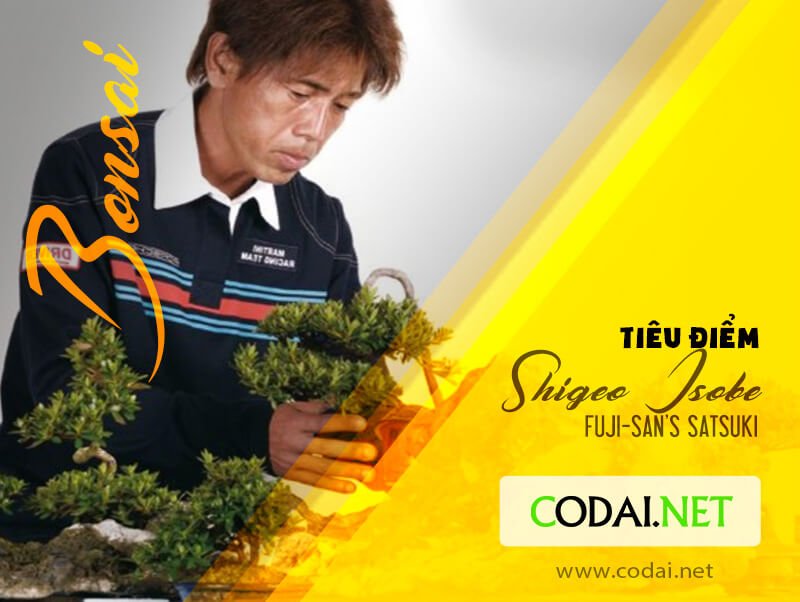Bonsai Focus Magazine, Chia sẻ kinh nghiệm, Người nổi tiếng, Satsuki
Bậc thầy Shigeo Isobe và tác phẩm Satsuki mô phỏng Fuji-san (núi Phú Sĩ)
Nguồn: Tạp chí Bonsai Focus English Edition T01/T02 2016
Dịch và biên tập: Dũng Cá Xinh (16/08/2021)
English
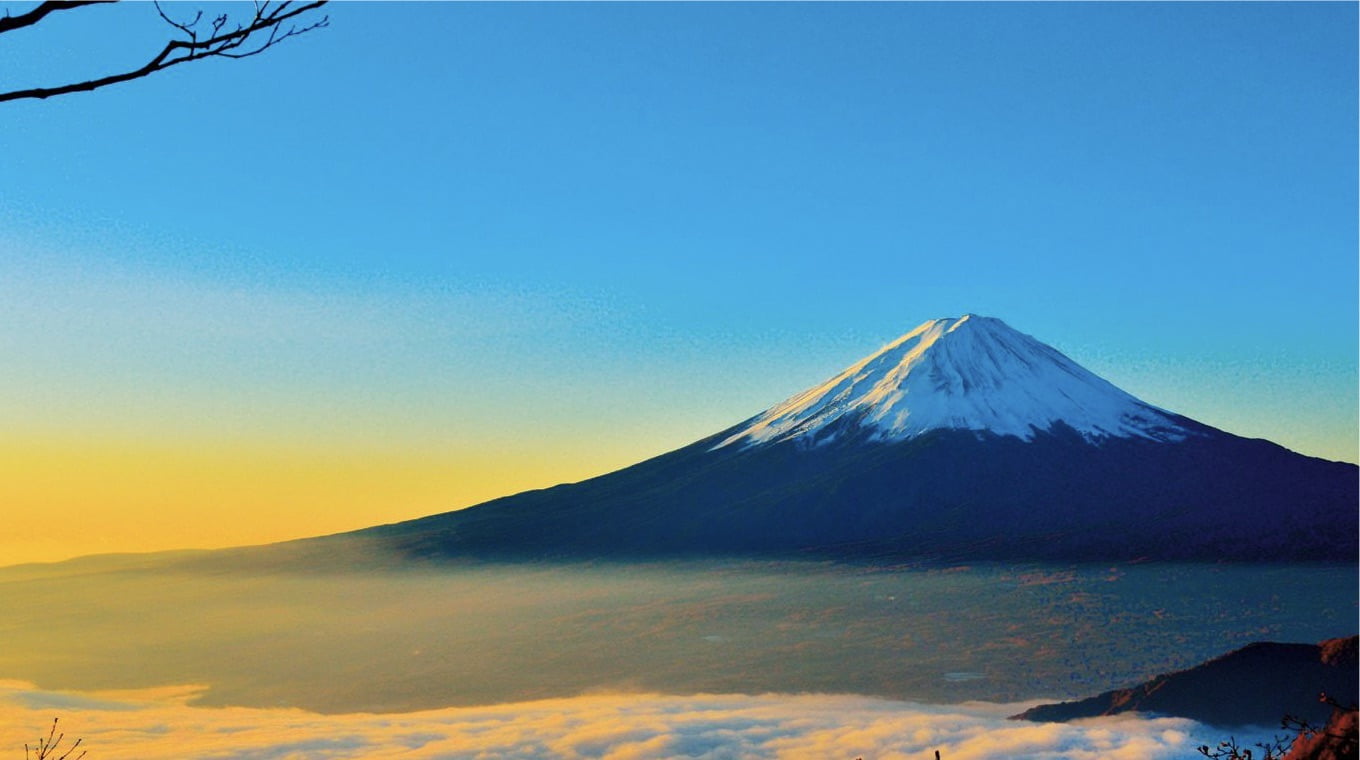
- Text and photography: Kinbon magazine, Japan
A rock that evokes images of the famous volcano Fuji, near Tokyo, is the centre stage for an unusual rock planting. The obsession of the artist can be seen forming on the rock. What scene will satsuki specialist, Shigeo Isobe create on this old Ibigawa rock?
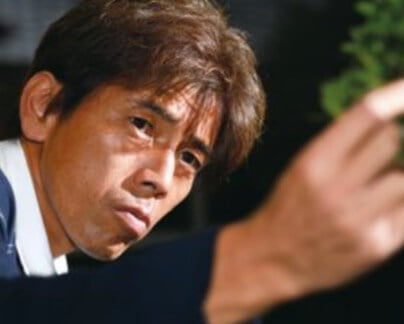
In order to use this stone without destroying the character, much artistic sensitivity is required, rather than technique. Will the iron man of satsuki bonsai, Mr Shigeo Isobe live up to the challenge and create a worthy scene?
Using the Masahiko Kimura technique of planting the rock in a pot
Mr Isobe has been studying underneath Masahiko Kimura for a number of years, seeking his guidance and taking advice on the more creative side of bonsai. He tells us, ‘It is important, however, that I do things that he doesn’t, or wouldn’t do, so I searched long and hard for this stone. It offers a wonderful scene that I cannot improve on by carving, but I intend to use the stone to its fullest potential by planting some azaleas on it. This is a very difficult task.’
A number of trees have been prepared for this make or break transformation, but the two possible pots for use will not hold the entire stone.
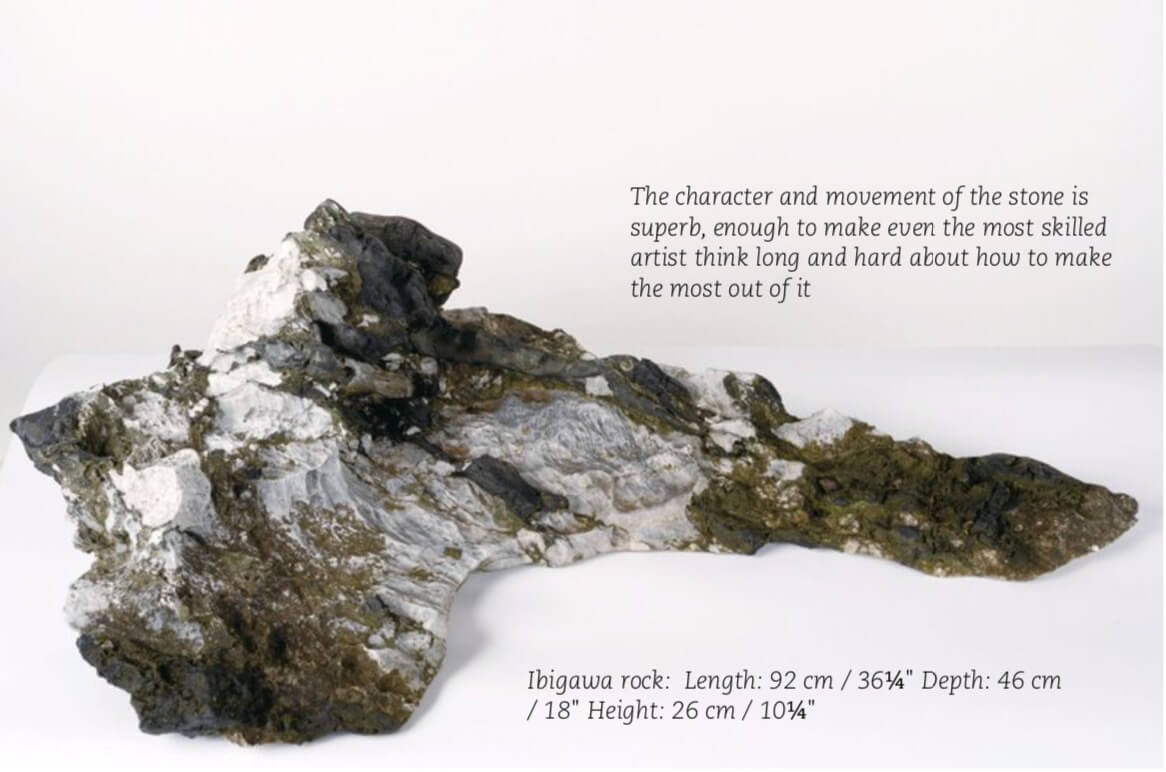
- The character and movement of the stone is superb, enough to make even the most skilled artist think long and hard about how to make the most out of it
- Ibigawa rock: Length: 92 cm / 361⁄4″ Depth: 46 cm / 18″ Height: 26 cm / 101⁄4″

Taller than Fuji
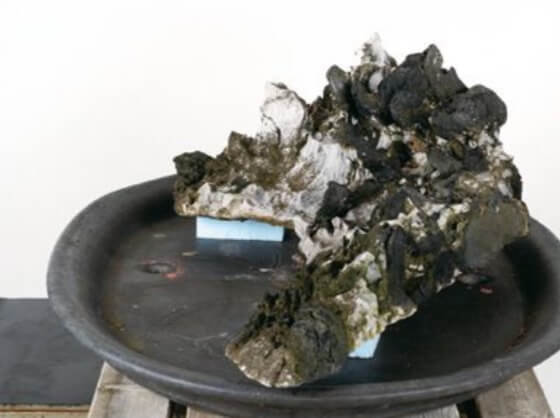
The rock planting by creative satsuki specialist, Shigeo Isobe, is not one that is straightforward. One of the reasons for this is that the character and style of the rock being used looks as though it is something you would see at the base of Mount Fuji.
When trying to match a tree to place with such a rock, the immediate logical thought is that there are no trees taller than a mountain top. So trees that are shorter than the ‘peak’ are chosen. Following on from that logic, you can say that, if Mount Fuji is in the distance and there is a tree just in front of you, it will look taller than Fuji. This brings to mind any number of famous pictures where Mount Fuji appears in the background framed by cascading branches.
If we use some very short, compact trees the main peak certainly does stand out; however, there is a difference between making the peak stand out and utilising its character to its maximum.
Round or oval? The choice of pot is crucial for the whole creation. The first attempt is with an oval pot
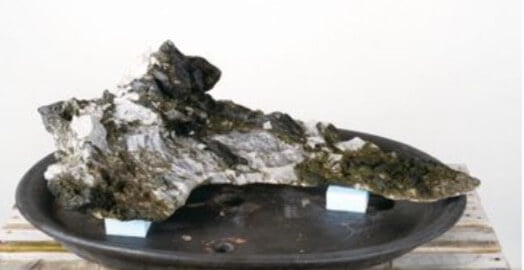
First, Shigeo Isobe tries to match the material with the rock in the oval pot. The rock protrudes slightly on the righthand side and fits comfortably at front to back. There will be no issues growing trees in this pot. That said, one of the important points is to utilise the space back to front to create a certain feel. It is not simply a case of creating space and throwing a tree in it without thought. Let’s start off by considering the trees we have available.
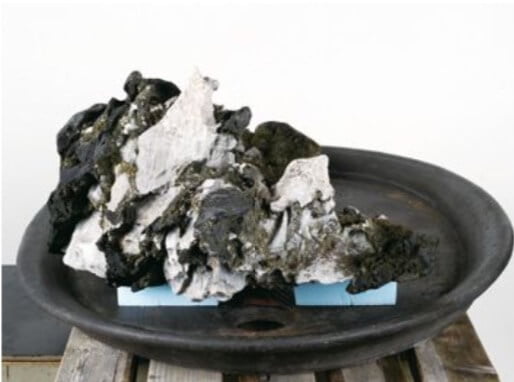
A matter of perspective: small trees to make the rock stand out
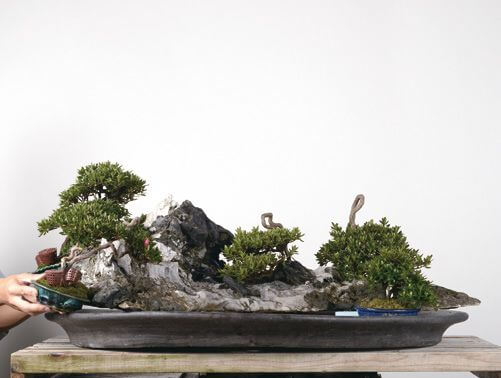
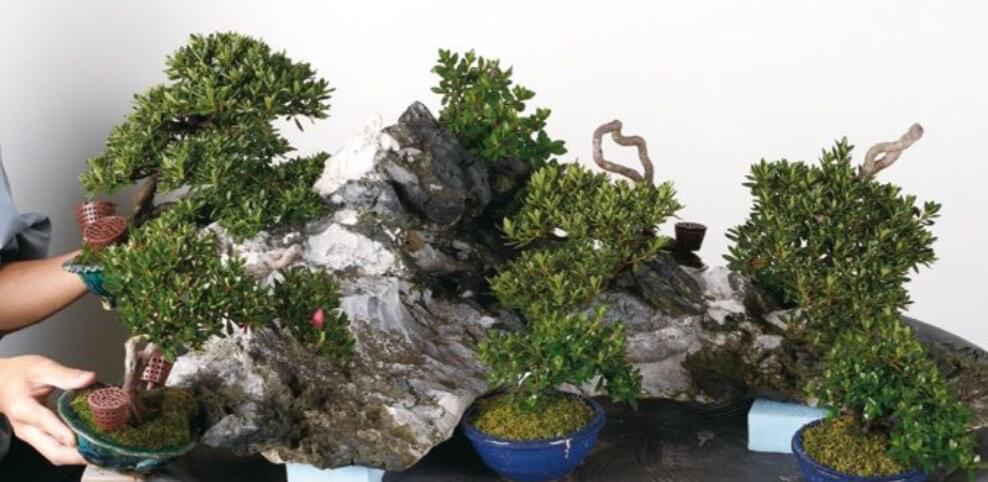
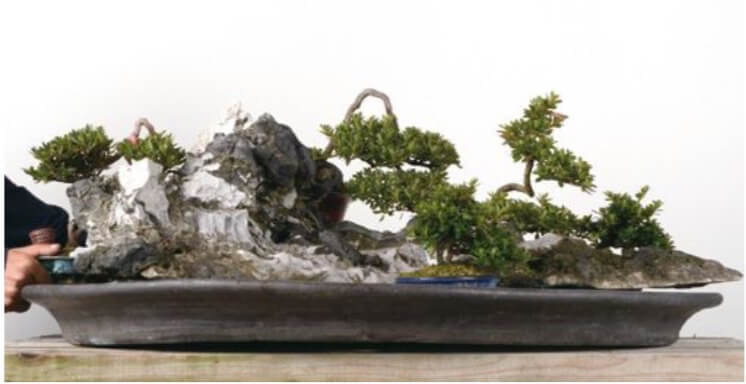
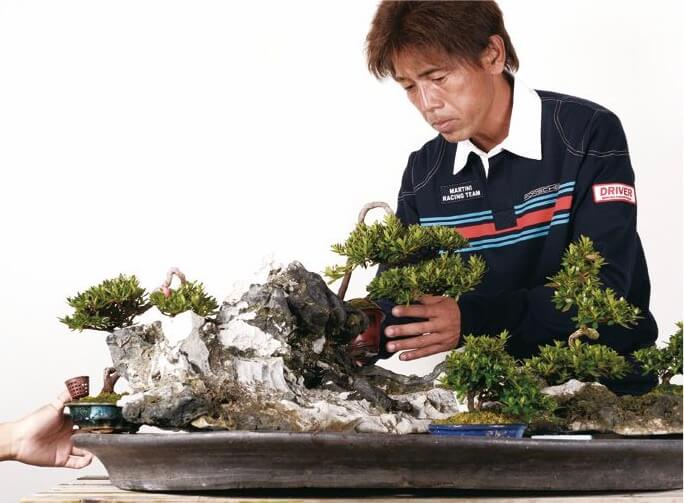
Trying a rectangular pot
Shigeo Isobe is not satisfied with the oval pot combination and so attempts something with a narrow rectangle, deliberately pushing the stone over the front, back and righthand edges. In order to do this, it is placed on blocks so that it isn’t touching the edges of the pot.
In comparison with the oval pot, the rock hangs over the edge of the pot a good deal more and there is much less space for the roots to grow, thereby giving it a much more confined image. Let’s see what image can be created.
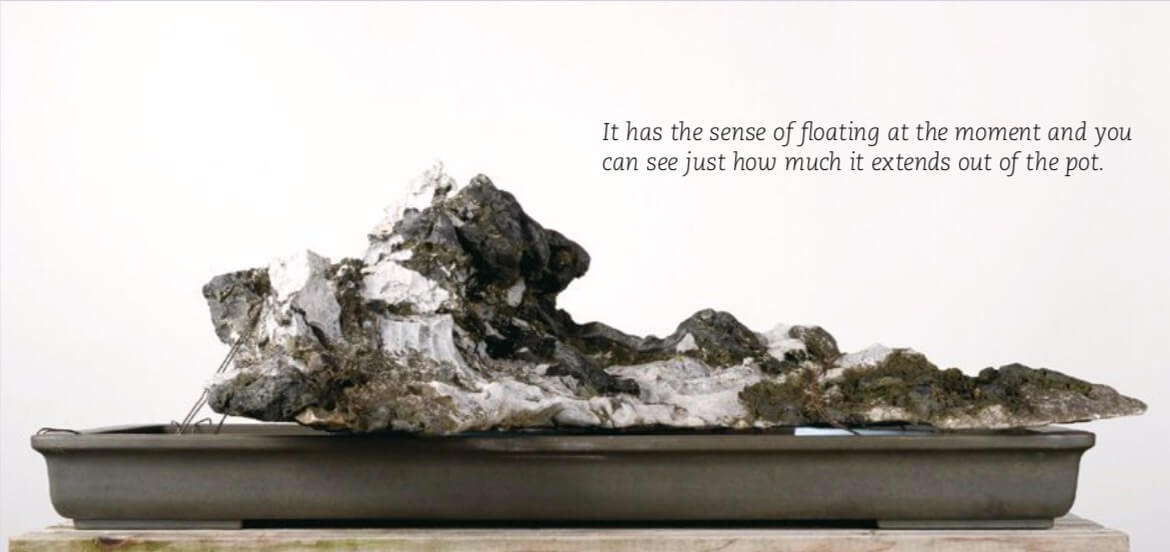
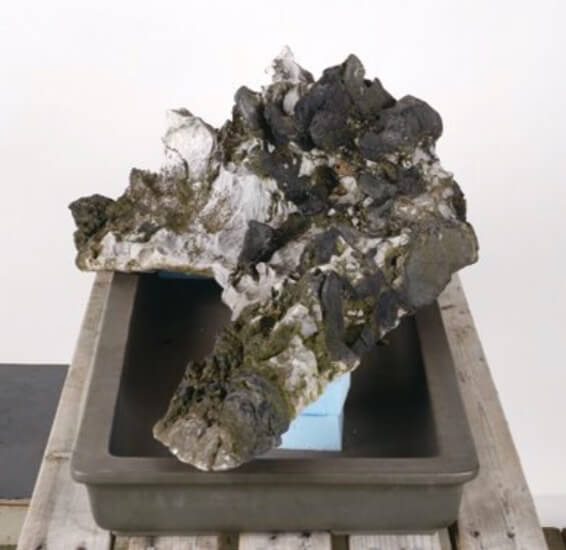
Change of perspective: Lower or higher?
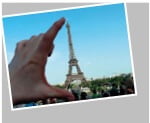
Shigeo Isobe has decided against trying to make a planting in the oval pot where all of the trees are lower than the central peak. Instead he is trying to use the long, narrow rectangular pot. Even though the pot is smaller, more confined and has a number of small trees, it still looks like a miniature box garden.
The plan to keep the central peak as the highest point has been abandoned as impractical.
The next tree to be tried is a relatively large tree placed to the left back. With the flow of the rock towards the right, the balance works fairly well; however, the heavy nature of the tree takes the eye away from the quality and character of the rock.
The next is a tall, thin, literati style tree, placed by itself to the left back. It is a high quality tree in itself and due to the lack of lower branches and visual weight in the trunk, the character of the rock is not overpowered. Although not the traditional way of using a rock, a move away from theory is starting to look good.
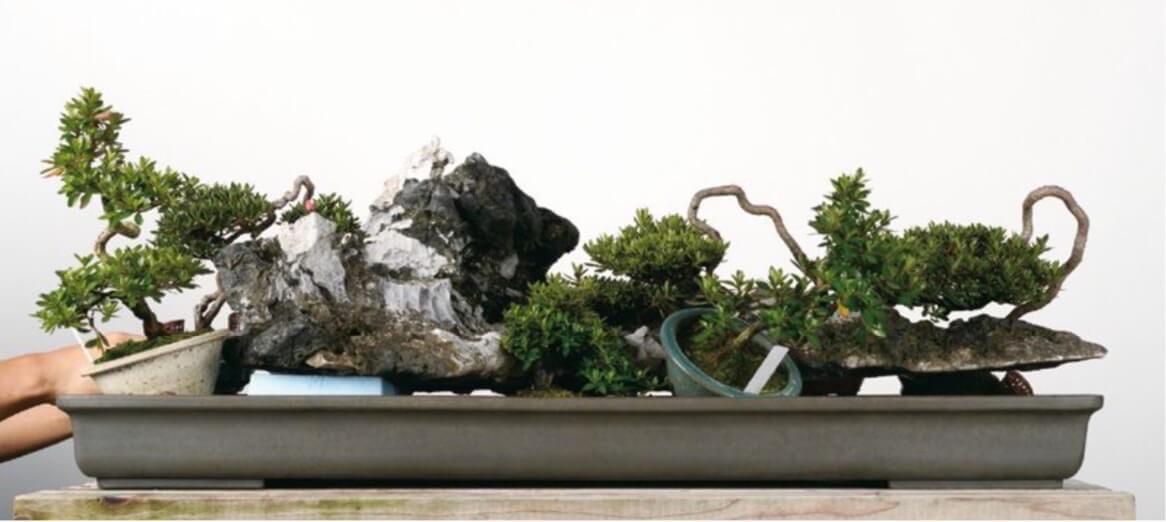

Inspired by Hokusai
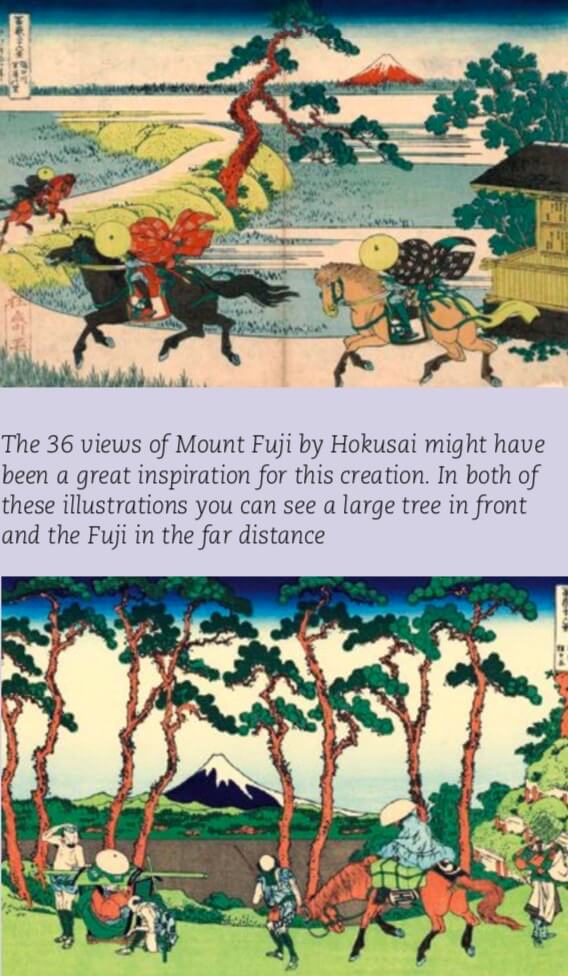
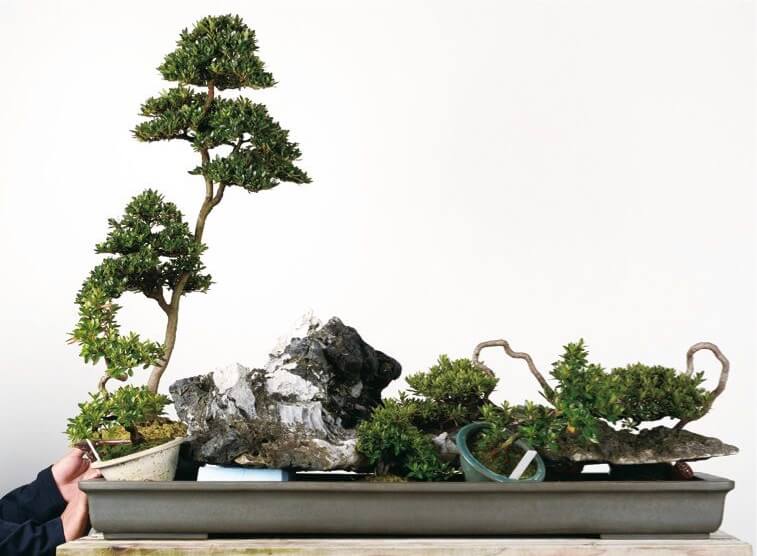
Preparing the satsuki material
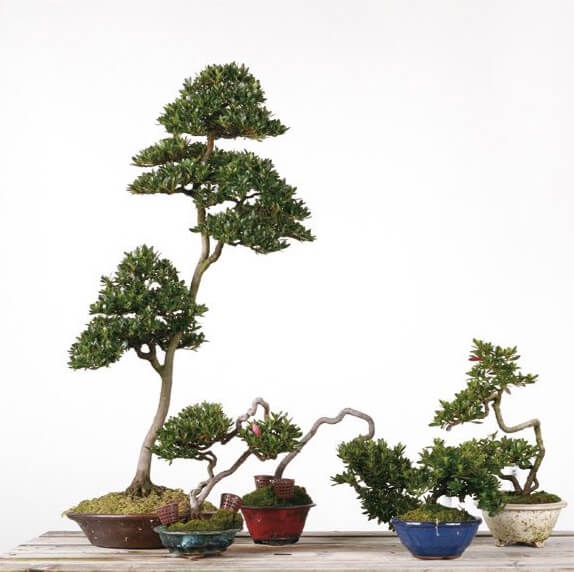
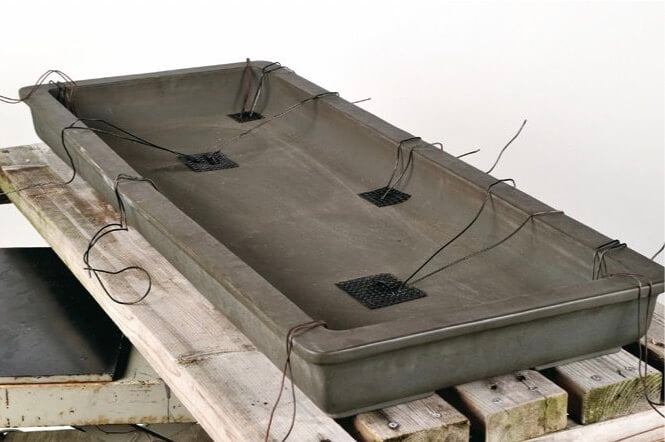

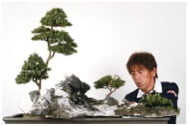
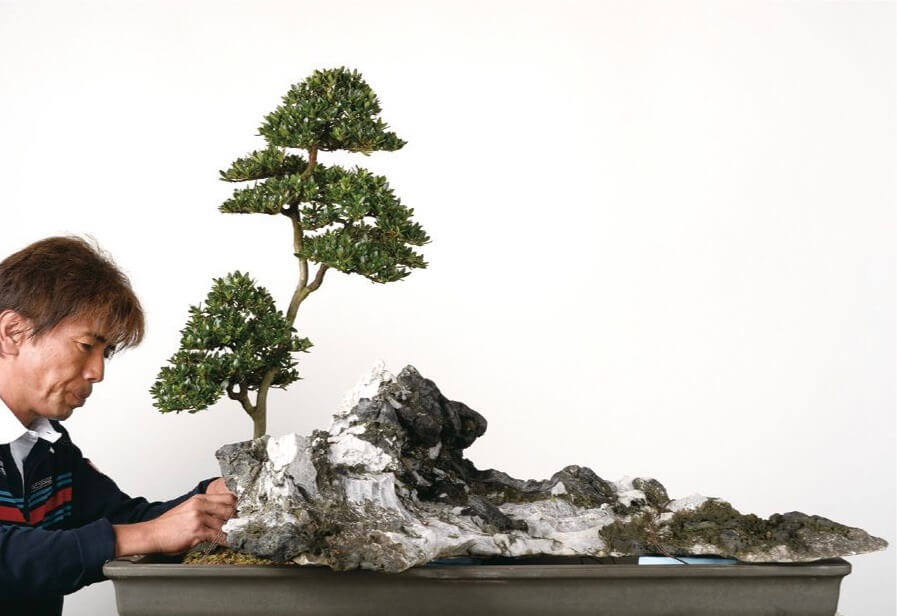
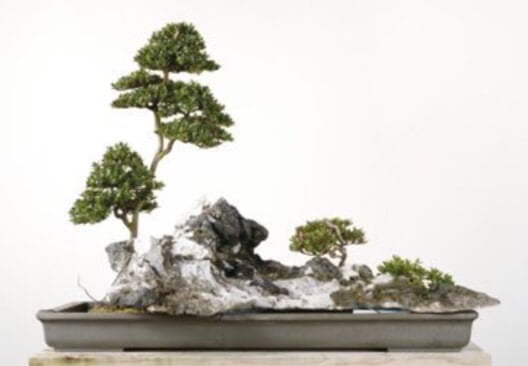
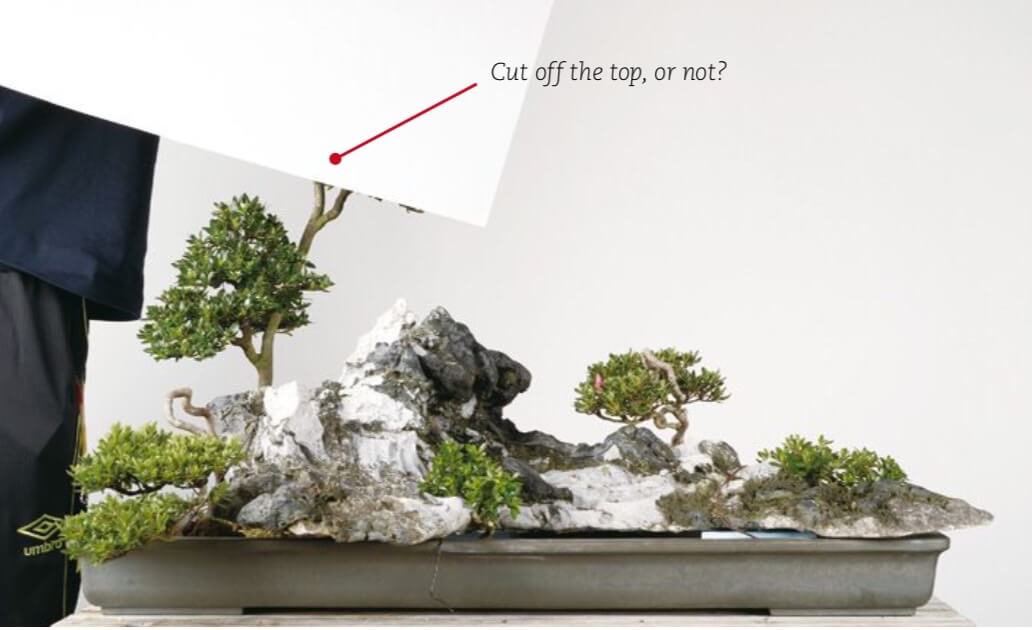
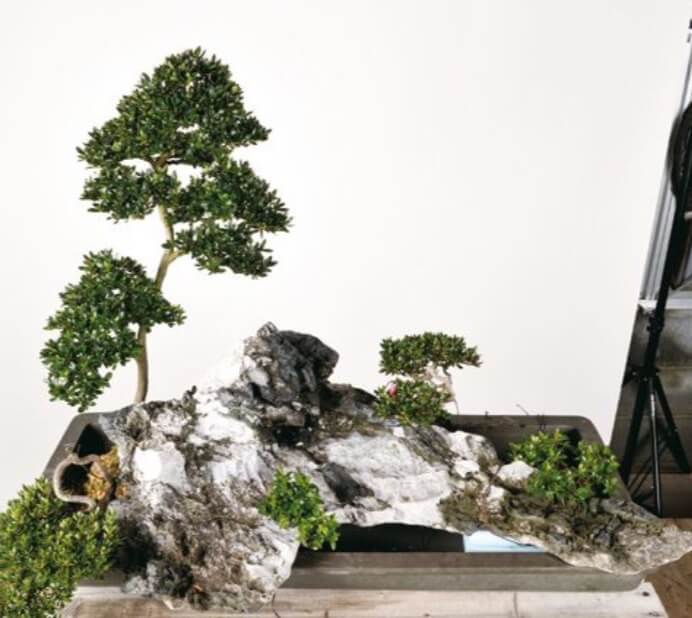
Each tree is fixed lightly and reconsidered
The position of each is considered from the front and the sides before it is tightened into the pot firmly. Even at this stage, the last tree to be considered is giving Shigeo Isobe great concern, the one on the lower left.
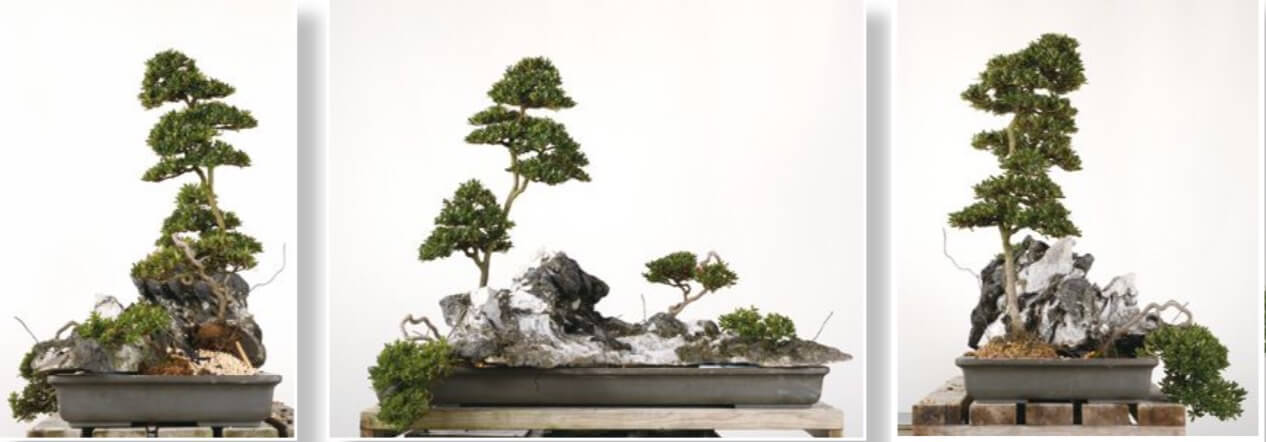
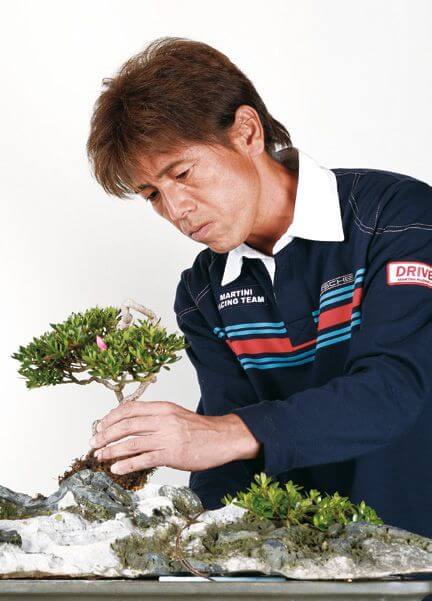
Obsession with the stone
Shigeo Isobe’s obsession with the character of the stone is strong. The tree prepared for the lower lefthand side is giving Shigeo Isobe great concern. It looks good without it, but it can also be used flowing to the front right or away from the rock towards the left.
With the tree flowing towards the front right, some of the character of the rock is lost. This isn’t what Shigeo Isobe wants since he is looking to make the most of the rock. He decides to use it flowing towards the left.
Shigeo. Isobe fixes the tree in the middle section, considering the angle and front
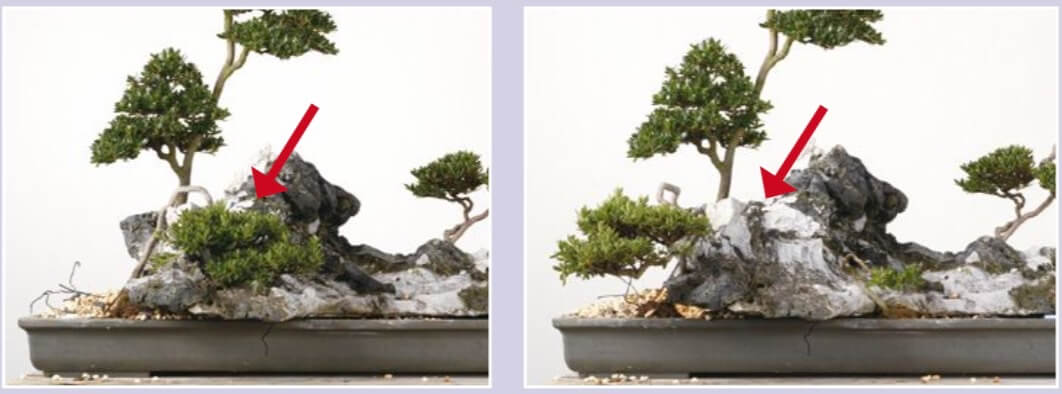

Considerations for creating rock plantings with azaleas
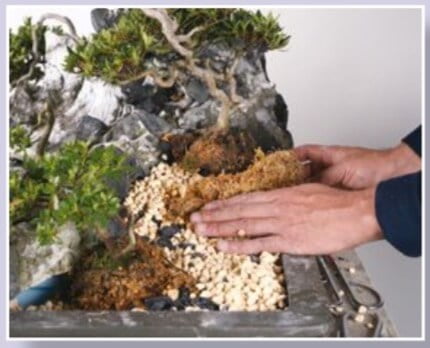
Now we have reached the final part of the rock planting, there are some important points to understand and consider: When creating rock planting with conifers, using Keto is a very valuable product to use. However, the very fine root structure of azaleas does not penetrate into the Keto in the same way that other species can.
In this rock planting we do not have many exposed roots or those which are going to be trained down the rock into soil and so the use of Keto is not required, simply Kanuma and sphagnum moss for top dressing.
In the case of creating a rock planting where the roots need to be trained down into the pot, or the pot is created from mesh and wire, Keto is an important ingredient.
Creating rock plantings with azaleas is difficult due to their horticultural requirements and growth habit, so special consideration is required.
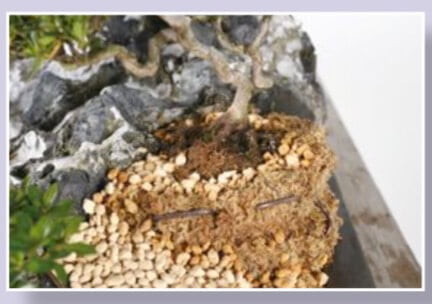
Final pruning and styling
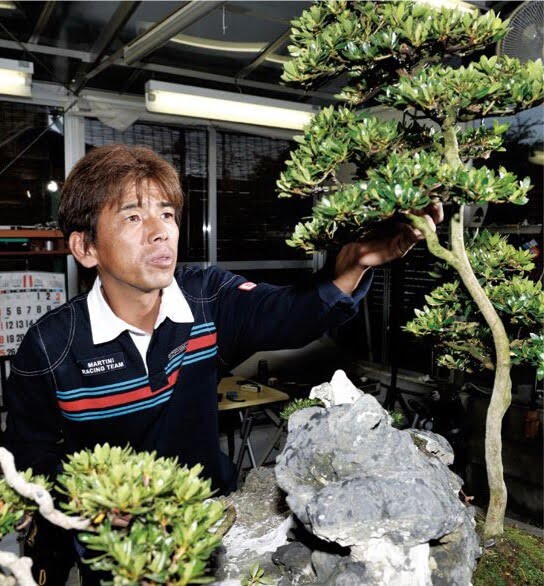 The trees were pretty much finished material when planted and so need little manipulation or pruning in order to finish the image.
The trees were pretty much finished material when planted and so need little manipulation or pruning in order to finish the image.
The point to consider when pruning is to accentuate the character of each individual tree after it has been planted at what may be a new angle or front. Each tree has a certain part to play in the overall design and so may need to be altered to suit that design. They can all be viewed individually and were initially created as such; however, slight but important alterations may be necessary.
Look at the literati tree, for example, and compare the before and after pruning images. The tree had a lofty, aloof air which was accentuated by lightening the foliage pads and creating more of a jaunty rhythm to the movement of trunk and branches, giving somewhat the feel of a Chinese landscape painting — an ideal match for the stone.
Although it might have been possible to create a miniature box garden with this idea, the artistry of the creator has ultimately shone through and he has created a beautiful scene.
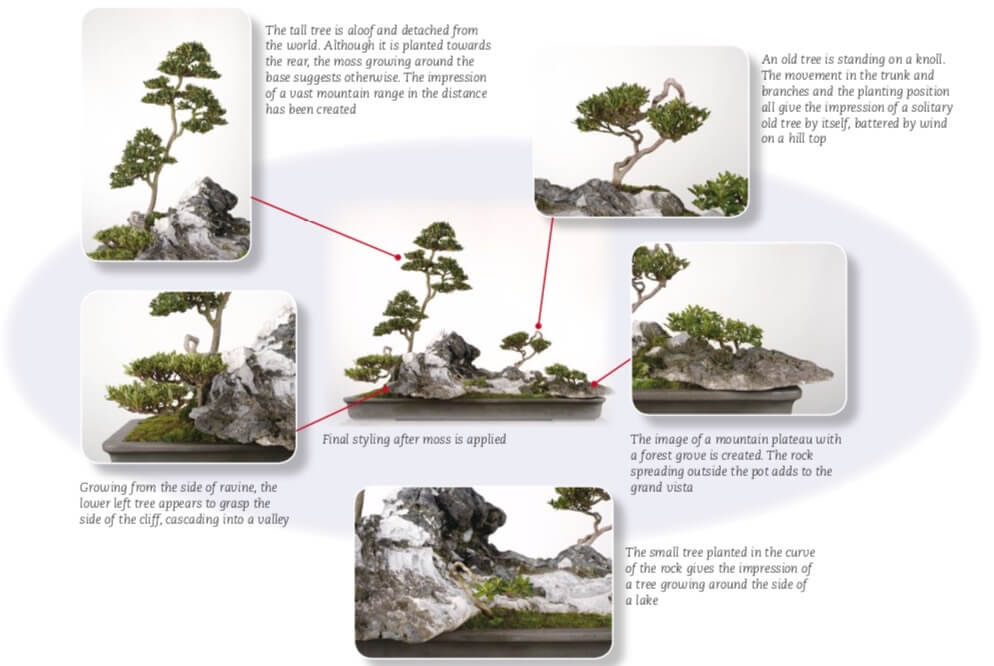
- The tall tree is aloof and detached from the world. Although it is planted towards the rear, the moss growing around the base suggests otherwise. The impression of a vast mountain range in the distance has been created
- An old tree is standing on a knoll. The movement in the trunk and branches and the planting position all give the impression of a solitary old tree by itself, battered by wind on a hill top
- Growing from the side of ravine, the lower left tree appears to grasp the side of the cliff, cascading into a valley
- Final styling after moss is applied
- The image of a mountain plateau with a forest grove is created. The rock spreading outside the pot adds to the grand vista
- The small tree planted in the curve of the rock gives the impression of a tree growing around the side of a lake
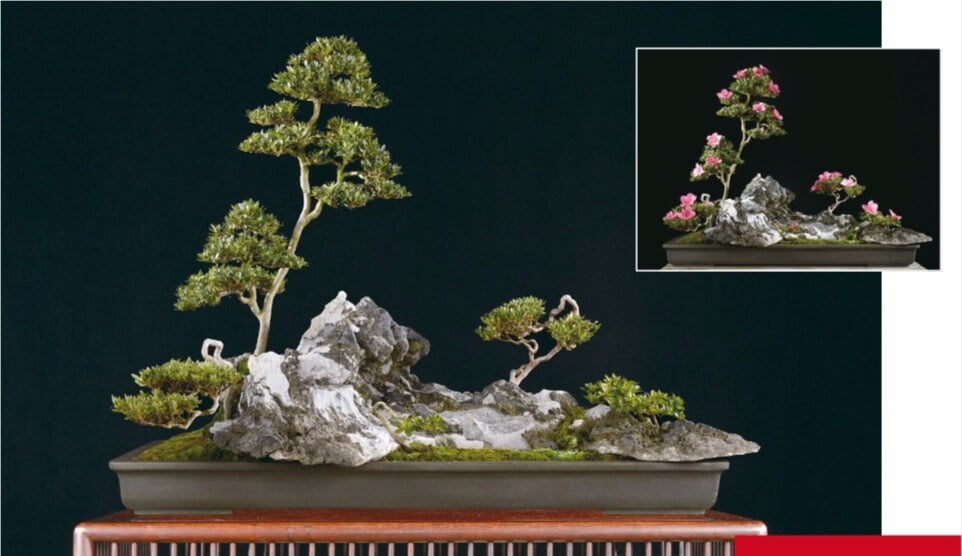
Tiếng Việt

- Bài và ảnh: Kinbon magazine, Japan
Một tảng đá gợi lên hình ảnh của ngọn núi lửa nổi tiếng Fuji (Phú Sĩ), gần Tokyo, là trung tâm của một tác phẩm Satsuki (Bonsai Hoa Đỗ Quyên) khác thường. Có thể thấy nỗi ám ảnh của người nghệ sĩ đang hình thành trên tảng đá. Chuyên gia satsuki, Shigeo Isobe sẽ tạo ra phong cảnh gì trên tảng đá Ibigawa cũ kỹ này?

Để sử dụng viên đá này mà không phá hủy đặc tính, cần phải có sự nhạy cảm về nghệ thuật hơn là kỹ thuật. Liệu ‘Iron Man’ trong vũ trụ Bonsai Satsuki, Mr Shigeo Isobe có thành công với thử thách và tạo ra một khung cảnh đắt giá?
Sử dụng kỹ thuật Masahiko Kimura để trồng đá trong chậu
Mr Isobe đã theo học thầy Masahiko Kimura trong một số năm, tìm kiếm sự hướng dẫn của ông và nhận lời khuyên về khía cạnh sáng tạo hơn trong nghệ thuật Bonsai. Anh ấy chia sẻ với chúng tôi, ‘Tuy nhiên, điều quan trọng là tôi làm những việc mà ông ấy không làm hoặc sẽ không làm, vì vậy tôi đã tìm kiếm rất lâu và chăm chỉ để có được viên đá này. Nó mang đến một khung cảnh tuyệt vời mà tôi không thể cải thiện bằng cách chạm khắc, nhưng tôi dự định sẽ sử dụng hết khả năng của nó bằng cách trồng một số cây Đỗ Quyên xen kẽ lên trên. Đây là một nhiệm vụ rất khó khăn. ‘
Một số cây đã được chuẩn bị cho quá trình chuyển đổi đột phá này, nhưng hai cái chậu có sẵn có lẽ không chứa được toàn bộ tảng đá.

- Đặc tính và chuyển động của viên đá là tuyệt vời, đủ để khiến ngay cả những nghệ nhân lành nghề nhất cũng phải suy nghĩ rất lâu về cách tận dụng tối đa nó
- Đá Ibigawa: Chiều dài: 92 cm / 361/4 “Chiều sâu: 46 cm / 18″ Chiều cao: 26 cm / 101/4 ”

Cao hơn núi Phú Sĩ

Việc sắp đặt đá của chuyên gia sáng tạo Satsuki, Shigeo Isobe, không phải là một công việc đơn giản. Một trong những lý do cho điều này là đặc điểm và phong cách của tảng đá đang được sử dụng trông như thể nó là thứ mà bạn sẽ thấy ở chân núi Phú Sĩ.
Khi cố gắng ghép một cái cây để đặt với một tảng đá như vậy, suy nghĩ logic ngay lập tức là không có cây nào cao hơn đỉnh núi. Vì vậy những cây thấp hơn ‘đỉnh’ được chọn. Theo logic đó, bạn có thể nói rằng, nếu núi Phú Sĩ ở phía xa và có một cái cây ngay trước mặt bạn, nó sẽ trông cao hơn Phú Sĩ. Điều này gợi nhớ đến bất kỳ bức ảnh nổi tiếng nào có núi Phú Sĩ xuất hiện trong nền được đóng khung bởi những cành cây xếp tầng.
Nếu chúng ta sử dụng một số cây rất ngắn, nhỏ gọn thì đỉnh chính chắc chắn nổi bật; tuy nhiên, có sự khác biệt giữa việc làm cho đỉnh nổi bật và sử dụng đặc tính của nó một cách tối đa.
Hình tròn hay hình bầu dục? Việc lựa chậu là rất quan trọng cho toàn bộ quá trình sáng tạo. Lần thử đầu tiên là với một cái chậu hình bầu dục

Đầu tiên, Shigeo Isobe cố gắng kết hợp vật liệu với tảng đá trong chậu hình bầu dục. Tảng đá nhô ra một chút ở phía bên tay phải và vừa vặn thoải mái từ trước ra sau. Sẽ không có vấn đề gì khi trồng cây trong chậu này. Điều đó nói lên rằng, một trong những điểm quan trọng là tận dụng không gian phía sau để tạo ra một cảm giác nhất định. Nó không chỉ đơn giản là một trường hợp tạo ra không gian và nhét một cái cây vào đó mà không cần suy nghĩ. Hãy bắt đầu bằng cách xem xét những cây chúng ta có sẵn.

Một vấn đề về góc độ: Những cây nhỏ sẽ làm cho tảng đá nổi bật




Thử nghiệm bằng một cái chậu hình chữ nhật
Shigeo Isobe không hài lòng với sự kết hợp chậu hình bầu dục và do đó, anh đã cố gắng làm một cái gì đó với một chậu hình chữ nhật hẹp, cố tình đẩy viên đá qua các cạnh trước, sau và bên phải. Để làm điều này, nó được đặt trên các viên gạch kê bên đưới để tảng đá không chạm vào các cạnh của chậu.
So với chậu hình bầu dục, tảng đá treo trên mép chậu nhiều hơn và có ít không gian hơn cho rễ phát triển, do đó tạo cho nó một hình ảnh hạn chế hơn nhiều. Hãy xem những gì hình ảnh có thể được tạo ra.


Thay đổi phối cảnh: Thấp hơn hay cao hơn?

Shigeo Isobe đã quyết định không cố gắng trồng trong chậu hình bầu dục, nơi tất cả các cây đều thấp hơn đỉnh trung tâm. Thay vào đó, anh cố gắng sử dụng cái chậu hình chữ nhật dài và hẹp. Mặc dù chậu nhỏ hơn, chật chội hơn và có một số cây nhỏ nhưng nó vẫn giống như một khu vườn thu nhỏ.
Kế hoạch giữ đỉnh trung tâm là điểm cao nhất đã bị từ bỏ vì không thực tế.
Cây tiếp theo sẽ được thử là một cây tương đối lớn được đặt ở phía sau bên trái. Với dòng chảy của đá về phía bên phải, sự cân bằng hoạt động khá tốt; tuy nhiên, bản chất nặng nề của cây làm mất đi chất lượng và đặc tính của tảng đá.
Tiếp theo là một cái cây cao, mảnh, dáng văn nhân, được đặt ở phía sau bên trái. Bản thân nó là một cây có chất lượng cao và do không có cành thấp hơn và trọng lượng thị giác ở thân cây, đặc tính của tảng đá không bị chế ngự. Mặc dù không phải là cách sử dụng đá truyền thống, nhưng việc rời xa lý thuyết đang bắt đầu có vẻ hiệu quả.


Lấy cảm hứng từ Hokusai


Chuẩn bị các cây Đỗ Quyên (Satsukai) nguyên liệu








Mỗi cây được cố định tạm thời và xem xét lại
Vị trí của mỗi câyi được xem xét từ phía trước và hai bên trước khi nó được cố định chặt vào chậu một cách chắc chắn. Ngay cả ở giai đoạn này, cây cuối cùng được xem xét đang khiến Shigeo Isobe quan tâm rất nhiều, cây ở phía dưới bên trái.


Nỗi ám ảnh với đá
Nỗi ám ảnh của Shigeo Isobe về đặc tính của viên đá rất mạnh mẽ. Cái cây chuẩn bị cho phía dưới bên tay trái khiến Shigeo Isobe rất lo lắng. Không có nó thì vẫn đẹp, nhưng nó cũng có thể được sử dụng để tạo dòng chảy ra phía trước bên phải hoặc từ tảng đá về phía bên trái.
Với cây có dòng chảy về phía trước bên phải, một số đặc điểm của tảng đá sẽ bị che mất. Đây không phải là điều mà Shigeo Isobe muốn vì anh ấy đang tìm cách tận dụng tối đa tảng đá. Anh ta quyết định sử dụng để nó nghiêng về phía bên trái.


Những lưu ý khi làm tác phẩm trồng cây lên đá với cây Đỗ Quyên

Bây giờ chúng ta đã đến phần cuối cùng của tác phẩm, có một số điểm quan trọng cần hiểu và cân nhắc: Khi trồng cây lá kim lên đá, Keto là một sản phẩm rất có giá trị sử dụng. Tuy nhiên, cấu trúc rễ rất tốt của Đỗ Quyên không xâm nhập vào Keto theo cách mà các loài khác có thể làm được.
Trong cách trồng trên đá này, chúng tôi không có nhiều rễ lộ ra ngoài hoặc rễ sẽ đâm xuống đá thành đất và vì vậy việc sử dụng Keto là không cần thiết, chỉ cần Kanuma và rêu sphagnum để bón thúc.
Trong trường hợp tạo một hòn non bộ mà rễ cây cần được chôn xuống chậu, hoặc chậu được tạo ra từ lưới và dây, Keto là một thành phần quan trọng.
Việc trồng cây trên đá với Đỗ Quyên rất khó do yêu cầu chăm sóc và thói quen sinh trưởng của chúng, vì vậy cần phải nghiên cứu rất kỹ.

Cắt tỉa và tạo kiểu cuối cùng

Cây lúc được trồng đã gần như đã qua giai đoạn cây nguyên liệu và vì vậy cần rất ít thao tác hoặc cắt tỉa để hoàn thiện hình ảnh.
Điểm cần lưu ý khi cắt tỉa là làm nổi bật đặc tính của từng cây riêng lẻ sau khi đã được trồng ở góc độ hoặc mặt tiền mới. Mỗi cây có một phần nhất định để tận dụng trong thiết kế tổng thể và vì vậy có thể cần được thay đổi để phù hợp với thiết kế đó. Tất cả chúng đều có thể được ngắm một cách riêng lẻ và mục đích ban đầu là như vậy; tuy nhiên, những thay đổi nhỏ nhưng quan trọng có thể sẽ cần thiết.
Ví dụ, hãy nhìn vào cây dáng Văn Nhân và so sánh hình ảnh trước & sau khi được cắt tỉa. Cây có một bầu không khí cao cả, xa cách, được tạo điểm nhấn bằng cách làm nhẹ bớt các tán lá và tạo thêm nhịp điệu vui tươi cho chuyển động của thân và cành, phần nào mang lại cảm giác như một bức tranh phong cảnh Trung Quốc – một sự kết hợp lý tưởng cho đá.
Mặc dù có thể tạo ra một khu vườn thu nhỏ với ý tưởng này, nhưng cuối cùng nghệ thuật của người sáng tạo đã tỏa sáng và anh ấy đã tạo ra một khung cảnh tuyệt đẹp.

- Cây cao thì xa cách và tách biệt với thế giới. Mặc dù nó được trồng về phía sau, nhưng rêu mọc xung quanh gốc lại cho thấy điều ngược lại. Ấn tượng về một dãy núi rộng lớn ở phía xa đã được tạo ra
- Một cây cổ thụ đang đứng trên gò. Sự chuyển động của thân, cành và vị trí trồng đều tạo cảm giác như một thân cây cổ thụ trơ trọi, bị gió quật ngã trên đỉnh đồi
- Mọc từ một bên khe núi, cây thấp bên trái dường như bám bên vách đá, xếp tầng tạo thành một thung lũng
- Tạo kiểu cuối cùng sau khi phủ rêu
- Hình ảnh của một cao nguyên núi với một rừng cây được tạo ra. Tảng đá trải rộng bên ngoài chậu làm tăng thêm không gian rộng lớn
- Cây nhỏ được trồng theo đường cong của đá tạo cảm giác như cây mọc quanh thành hồ.

